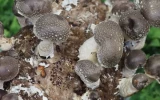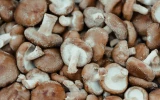Easy Coco Coir Substrate Recipe to Make at Home
Your choice of substrate, or the medium where you will grow your mushrooms, defines your overall mushroom-growing experience. Coco coir is one of the most accessible types of substrates that you can purchase at your local garden store. If you’re eager to use coco coir as a substrate, here’s an easy recipe to make coco coir at home.
The easiest coco coir substrate recipe to make is composed of one part 100% natural coco coir and one part vermiculite. The vermiculite is used to maintain moisture and help with airflow. You can add gypsum to stabilize the pH level and as a mineral source or coffee grounds as a nitrogen source.
Using coco coir as a substrate has many benefits. Coco coir can easily be made into a bulk substrate, and it requires no sterilization. You’ll find out more about the benefits of using coco coir as a substrate as you read below.
Summary
- Coco coir with vermiculite is an easy substrate that you can make at home which you can use to grow your mushrooms.
- The best coco coir substrate recipe is composed of a 1:1 ratio of coco coir and vermiculite, supplemented with gypsum and mixed in boiling water to pasteurize.
- Coco coir is a high-quality substrate because of its ability to tolerate bacteria and molds, plus, it can expand to hold moisture.

On this page:
Coco Coir and Vermiculite Is the Easiest Coco Coir Substrate Recipe
While there are many types of substrates that you can use to grow your mushrooms, one of the most recommended options is the coco coir substrate. Coco coir is produced from the extraction of coconut fibers from coconut husks. It is basically made up of fibers from coconut shells and is considered 100% organic.
The easiest coco coir substrate recipe to make is a combination of coco coir and vermiculite. The correct ratio of coco coir to vermiculite must be 1:1.
The advantage of using coco coir is that it meets all the requirements of a high-quality substrate. Since it is derived from coconut husks, it is rich in organic matter. It’s also readily available and environmentally friendly since it is a waste product that’s being reused.
Coco coir also has a balanced pH, and its fibers can expand to hold moisture. Aside from this, properly prepared coco coir can help fight off molds and bacteria. This substrate has exhibited amazing results when growing a species of mushroom called Psilocybe cubensis.

Vermiculite, being a porous substance, helps retain moisture and aids in airflow. Some growers add gypsum to stabilize the pH level and as an additional source of minerals and other trace elements. This substrate recipe is commonly called CVG, which stands for coco coir, vermiculite, and gypsum. Other growers use coffee grounds instead of gypsum to add more sources of nitrogen to the mycelium.
When farming plants and crops, you need nutrient-rich soil to maintain the healthy growth of your plants. Although in the wild, some mushrooms grow in soil or on decaying logs, in commercial or indoor cultivation, a substrate is used.
Soil is the equivalent of substrates in indoor mushroom production. Having a high-quality substrate for your mushrooms makes all the difference in terms of your mushroom yield. A more nutritious substrate speeds up the colonization process and produces healthier mushrooms.

A mushroom substrate aims to provide energy, water, nutrients, and a conducive environment for your mushrooms. A high-quality mushroom substrate must have the following characteristics:
- Must be rich in fibrous material like lignin and cellulose
- Must have good absorption characteristic
- Must tolerate harsh conditions
- Must be resistant to pests, bacteria, and other fungi
To decrease the competition of mycelium with bacteria and molds, the substrate must undergo sterilization or pasteurization. Sterilization is performed for high-nutrient substrates such as manure, wheat bran, and soybean hulls, while pasteurization is done for less nutritious substrates like coco coir and straw.
Aside from the sterilization or pasteurization process, adding supplements to your substrates is necessary. At least 1–2% of nitrogen is needed in your substrate. Coffee grounds are a good source of nitrogen.
Your substrate, to be ideal, must also have ample amounts of magnesium, phosphorus, sulfur, potassium, and calcium. It must achieve a slightly acidic pH of 5-6.5 and have at least 50–70% moisture content. If you perform a drop test, it should only yield a few drops of water.
Step-by-Step Guide to Making Coco Coir and Vermiculite Substrate
If you have been convinced about the great advantages of using coco coir and vermiculite as substrate and want to know how to make one, follow these simple steps below:
1. Gather your supplies
Before anything else, you must gather all the ingredients and equipment you will need. Below is a list of specific ingredients needed to make a bulk substrate of coco coir and vermiculite.
| Ingredients for the substrate | Quantity |
|---|---|
| 1 brick of coco coir | 650 grams |
| Fine dry vermiculite | 8 cups |
| Gypsum | 1 cup |
| Water | 16 cups |
Some of the materials or equipment needed in the making process are the following:
- One large pot
- One large bucket with cover
- Measuring cups
- Stirrer or spoon
2. Boil the water in the large pot
When all ingredients and equipment are prepared, add the water to the large pot and bring it to a boil. Lower the temperature to 165°F (74°C) which is the ideal temperature for pasteurization.
3. Add ingredients to the bucket
Collect the brick of coco coir and the vermiculite and add them to the bucket. Add gypsum at this stage so it will also be pasteurized. Pour the recently boiled water into the bucket.
4. Mix the ingredients with water thoroughly
There are three different methods to mix the coco coir and vermiculite substrate mixture thoroughly. It will require a strong spoon or stirrer to evenly distribute the vermiculite to the coco coir properly.
Mixing is an important process as breaking up the substrate into pieces produces more surface area for the mycelium to colonize, thus speeding up colonization.
Mix the substrate before closing the bucket
When you add the boiling water to the bucket with coco coir, break it up with a spoon until no lumps or dry spots are visible. Add the vermiculite and gypsum at the same time and mix the ingredients well. Close the lid and leave the mixture at room temperature for at least 6 hours to cool down before moving on to inoculation.
Mix the substrate after an hour
When you add the boiling water to the bucket with all the other ingredients, close the lid. After an hour passes, open the lid and stir the mixture well to blend all the ingredients. After mixing, close the lid again and let the mixture cool down for at least 6 hours.
Mix the substrate after it has cooled down

This method works best if you don’t like to deal with hot mixtures. When you poured the water into the bucket with coco coir, vermiculite, and gypsum, close the bucket cover.
After 6 to 8 hours, open the bucket and mix all the ingredients thoroughly using a strong spoon or stirrer. You will know you have created a nicely pasteurized substrate when if you squeeze a handful of it, no parts will fall out and only a few drops of water come out.
Too many drops falling out will mean that the substrate is too wet. If no drop of water comes out and the substrate dismantles in your hand, it will mean that the substrate is too dry.
If all is well upon the squeeze test, keep your mixture at room temperature until it is ready to use.



